1993 BUICK PARK AVENUE overheating
[x] Cancel search: overheatingPage 11 of 340
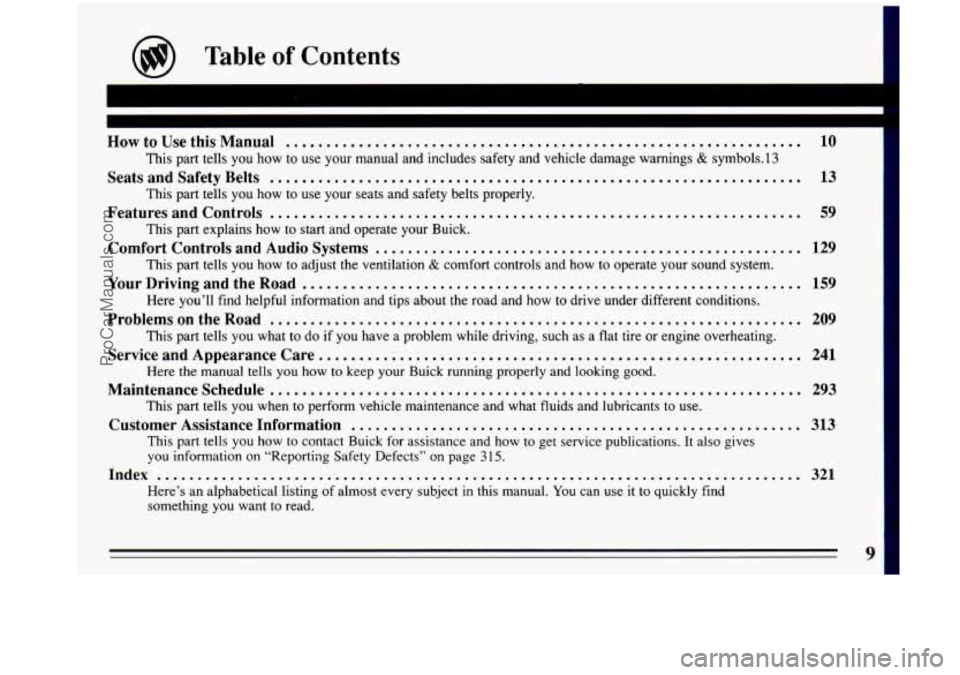
@ Table of Contents
HowtoUsethisManual ................................................................ 10 1
This part tells you how to use your manual and includes safety and vehicle damage warnings & symbols. 13
This part tells you how to use your seats and safety belts properly.
This part explains how to start and operate your Buick.
This part tells you how to adjust the ventilation
& comfort controls and how to operate your sound system.
Here you’ll find helpful information and tips about the road and how to drive under different conditions.
This part tells you what to do if you have a problem
while driving, such as a flat tire or engine overheating.
Here the manual tells you how to keep your Buick running properly and looking good.
This part tells you when to perform vehicle maintenance and what fluids and lubricants to use.
This part tells you how to contact Buick for assistance and how to get service publications. It also gives
you information on “Reporting Safety Defects” on page 315.
Here’s an alphabetical listing of almost every subject in this manual.
You can use it to quickly find
something you want to read.
SeatsandSafetyBelts .................................................................. 13
FeaturesandControls
.................................................................. 59
Comfort Controls and Audio Systems
..................................................... 129
YourDrivingandtheRoad
.............................................................. 159
ProblemsontheRoad
.................................................................. 209
Service and Appearance Care..
.......................................................... 241
Maintenanceschedule
.................................................................. 293
Customer Assistance Information
........................................................ 313
Index
........................................................................\
........ 321
ProCarManuals.com
Page 124 of 340
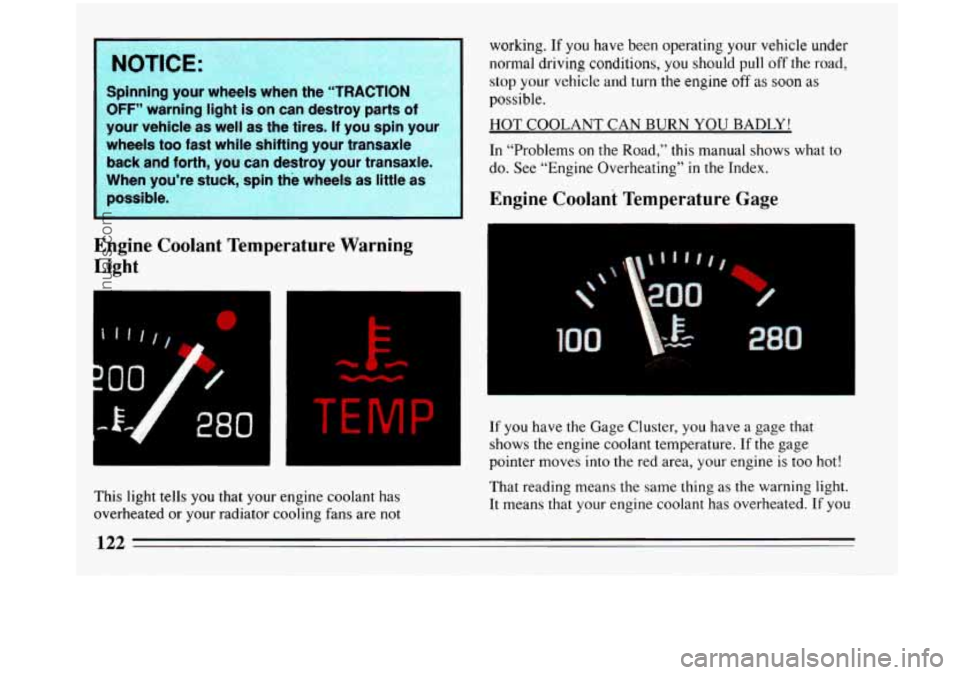
I NOTICE:
Spinning your wheels when the “TRACTION
OFF” warning light is on can destroy parts of
your vehicle as well as the tires.
If you spin your
wheels too fast while shifting your transaxle
back and forth, you can destroy your transaxle.
When you’re stuck, spin the wheels
as little as
possible.
~~~~~~
1
working. If you have been operating your vehicle under
normal driving conditions,
you should pull off the road,
Engine Coolant Temperature Warning
Light
7
280
stop your vehicle and turn the engine off as soon as
possible.
HOT COOLANT CAN BURN YOU BADLY!
In “Problems
on the Road,” this manual shows what to
do. See “Engine Overheating”
in the Index.
Engine Coolant Temperature Gage
100
.Id pointer moves into the red area, your engine is too hot!
If you have the Gage Cluster, you have a gage that
shows the engine coolant temperature.
If the gage
This light
tells you that your engine coolant has
overheated or your radiator cooling fans are
not
That reading means the same thing as the warning light.
It means that your engine coolant has overheated.
If you
122
ProCarManuals.com
Page 125 of 340
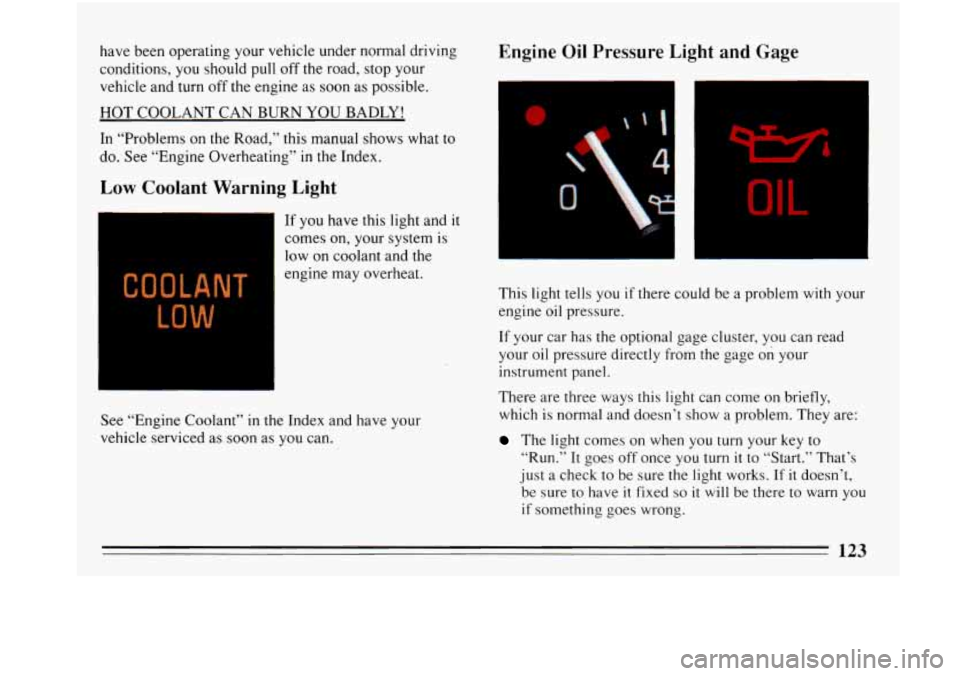
have been operating your vehicle under normal driving
conditions,
you should pull off the road, stop your
vehicle and turn off the engine as soon as possible.
HOT COOLANT CAN BURN YOU BADLY!
In “Problems
on the Road,” this manual shows what to
do. See “Engine Overheating”
in the Index.
Low Coolant Warning Light
I
1
If you have this light and it
comes on, your system
is
low on coolant and the
engine may overheat.
See “Engine Coolant” in the Index and have your
vehicle serviced as soon as you can.
Engine Oil Pressure Light and Gage
0‘ 1
I
This light tells you if there could be a problem with your
engine oil pressure.
If your car has the optional gage cluster, you can read
your oil pressure directly from the gage
on your
instrument panel.
There are three ways this light can come on briefly,
which
is normal and doesn’t show a problem. They are:
The light comes on when you turn your key to
“Run.” It goes off once you turn
it to “Start.” That’s
just a check to be sure the light works. If it doesn’t,
be sure to have it fixed so it will be there to warn you
if something goes wrong.
123
ProCarManuals.com
Page 208 of 340
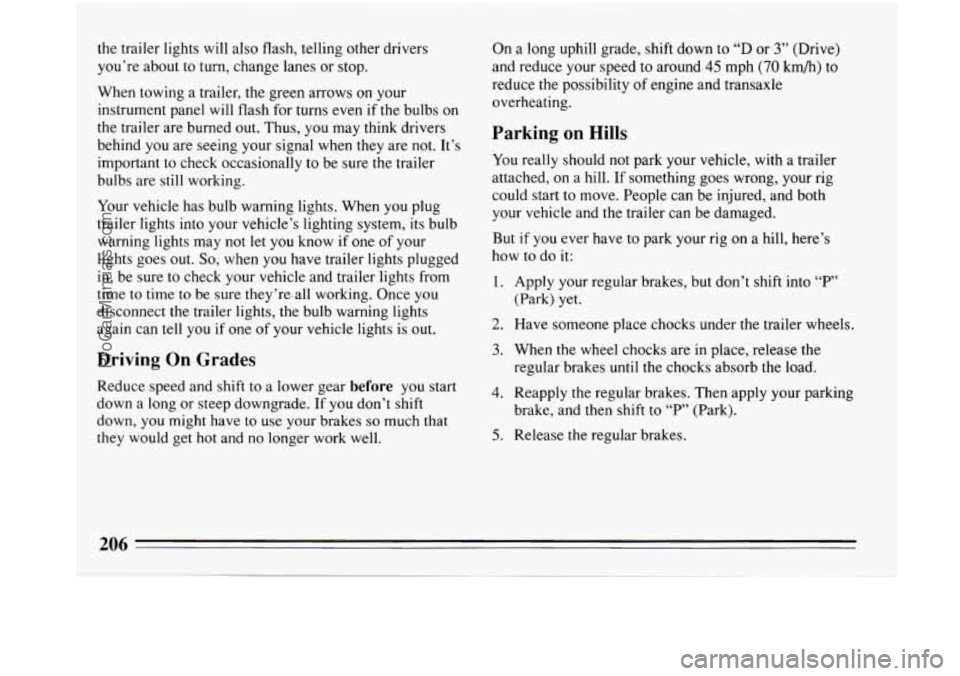
the trailer lights will also flash, telling other drivers
you’re about to turn, change lanes or stop.
When towing a trailer, the green arrows
on your
instrument panel will flash for turns even
if the bulbs on
the trailer are burned out. Thus, you may think drivers
behind you are seeing your signal when they are not. It’s
important to check occasionally to be sure the trailer
bulbs are still working.
Your vehicle has bulb warning lights. When you plug
trailer lights into your vehicle’s lighting system, its bulb warning lights may not
let you know if one of your
lights goes
out. So, when you have trailer lights plugged
in, be sure
to check your vehicle and trailer lights from
time to time to be sure they’re-all working. Once
you
disconnect the trailer lights, the bulb warning lights
again can
tell you if one of your vehicle lights is out.
Driving On Grades
Reduce speed and shift to a lower gear before you start
down a long
or steep downgrade. If you don’t shift
down, you might have to use your brakes
so much that
they would get hot and no longer work well. On
a long uphill grade, shift down to
“D or 3” (Drive)
and reduce your speed to around
45 mph (70 km/h) to
reduce the possibility of engine and transaxle
overheating.
Parking on Hills
You really should not park your vehicle, with a trailer
attached,
on a hill. If something goes wrong, your rig
could start to move. People can be injured, and both
your vehicle and the trailer can be damaged.
But
if you ever have to park your rig on a hill, here’s
how to do it:
1. Apply your regular brakes, but don’t shift into “F’”
(Park) yet.
2. Have someone place chocks under the trailer wheels.
3. When the wheel chocks are in place, release the
regular brakes until the chocks absorb the load.
4. Reapply the regular brakes. Then apply your parking
brake, and
then shift to “P’ (Park).
5. Release the regular brakes.
ProCarManuals.com
Page 211 of 340
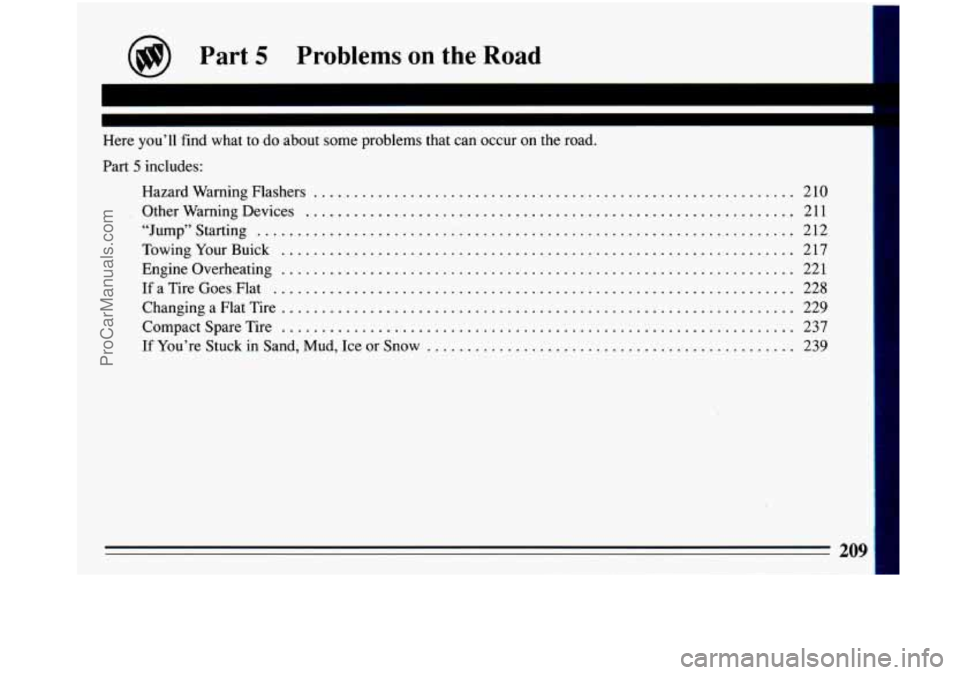
@ Part 5 Problems on the Road
=I i
~~
Here you’ll find what to do about some problems that can occur on the road .
Part 5 includes:
Hazard Warning Flashers
............................................................ 210
OtherWarningDevices
............................................................. 211
“Jump”Starting
.................................................................... 212
TowingYourBuick
................................................................ 217
Engineoverheating
................................................................ 221
IfaTireGoesFlat
................................................................. 228
ChangingaFlatTire
................................................................ 229
CompactSpareTire
................................................................ 237
If You’re Stuck
in Sand, Mud, Ice or Snow .............................................. 239
209
...... c-~ ~
ProCarManuals.com
Page 223 of 340
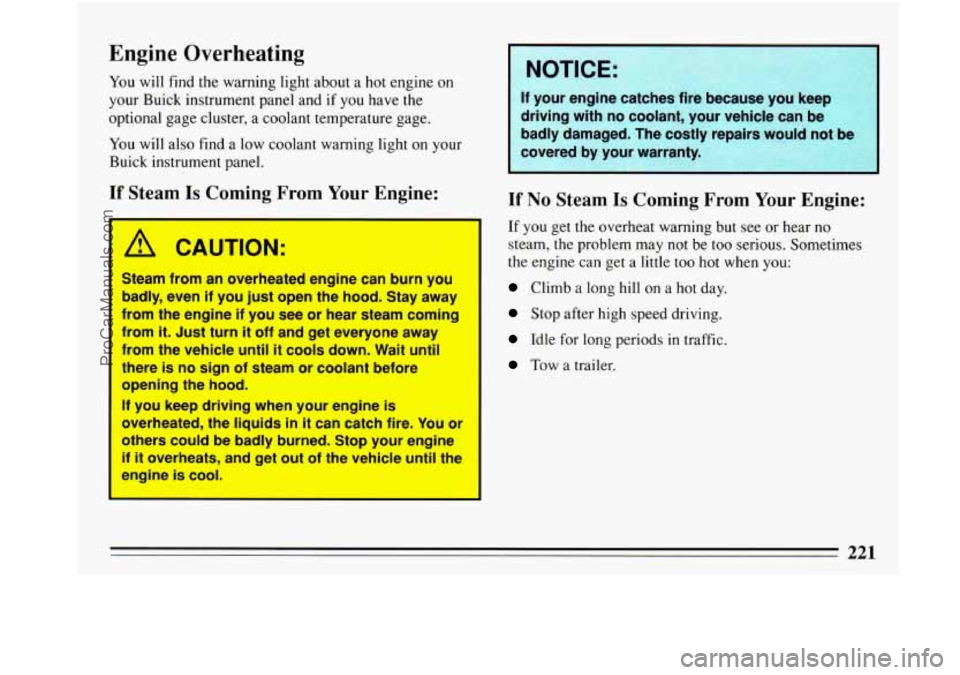
Engine Overheating
You will find the warning light about a hot engine on
your Buick instrument panel and if you have the
optional gage cluster,
a coolant temperature gage.
You will also find a low coolant warning light
on your
Buick instrument panel.
If Steam Is Coming From Your Engine:
A CAUTION:
- _earn from an overheated engine can burn you
badly, even
if you just open the hood. Stay away
from the engine
if you see or hear steam coming
.. -m it. Just turn it off and get everyone away
from the vehicle until it cools down. Wait until
there
is no sign of steam or coolant before
opening the hood.
If you keep driving when your engine is
overheated, the liquids in
it can catch fire. You or
others could be badly burned. Stop your engine
if it overheats, and get out of the vehicle until the
sngine is cool.
- -
If No Steam Is Coming From Your Engine:
If you get the overheat warning but see or hear no
steam, the problem may not be too serious. Sometimes
the engine can get a little
too hot when you:
Climb a long hill on a hot day.
Stop after high speed driving.
Idle for long periods in traffic.
Tow a trailer.
221
ProCarManuals.com
Page 225 of 340
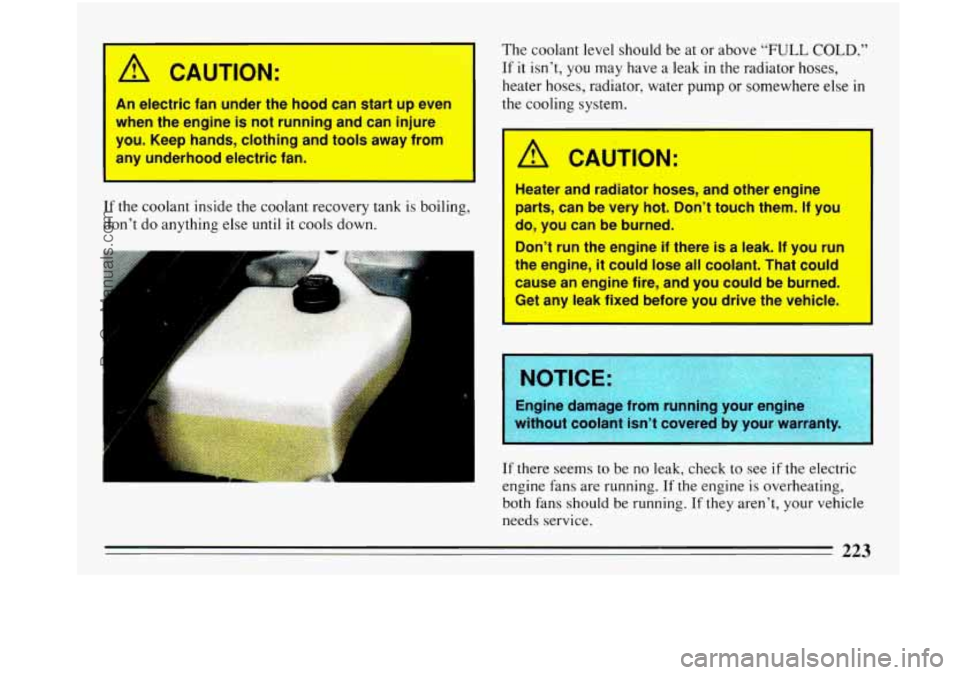
I A CAUTION:
An electric fan under the hood can start up even
when the engine
is not running and can injure
you. Keep hands, clothing and tools away from
any underhood electric fan.
If the coolant inside the coolant recovery tank is boiling,
don’t do anything else until it cools down.
. .” P
The coolant level should be at or above “FULL COLD.”
If it isn’t, you may have a leak in the radiator hoses,
heater hoses, radiator, water pump
or somewhere else in
the cooling system.
I I
A CAUTION:
Heater and radiator hoses, and other engine
parts, can be very hot. Don’t touch them.
If you
do, you can be burned.
Don’t run the engine
if there is a leak. If you run
the engine, it could lose all coolant. That could
cause an engine fire, and you could be burned.
Get any leak fixed before you drive the vehicle.
I
Engine damage? Il’onl I mning bUrlr engine
without coolant isn’t covered by your warrbllr
If there seems to be no leak, check to see if the electric
engine fans are running. If the engine
is overheating,
both fans should be running. If they aren’t, your vehicle
needs service.
223
ProCarManuals.com
Page 260 of 340
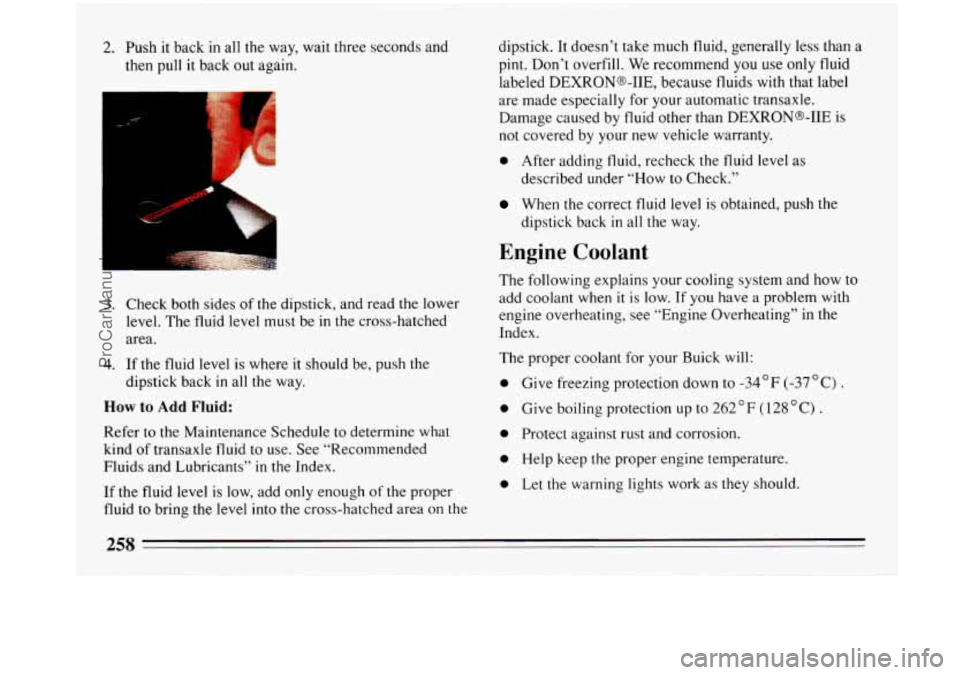
2. Push it back in all the way, wait three seconds and
then pull it back out again.
3. Check both sides of the dipstick, and read the lower
level. The fluid level must be in the cross-hatched
area.
4. If the fluid level is where it should be, push the
dipstick back
in all the way.
How to Add Fluid:
Refer to the Maintenance Schedule to determine what
kind of transaxle fluid to use. See “Recommended
Fluids and Lubricants” in the Index.
If the fluid level is low, add only enough of the proper
fluid to bring the level
into the cross-hatched area on the dipstick, It
doesn’t take much fluid, generally less than a
pint. Don’t overfill. We recommend
you use only fluid
labeled DEXRONWIE, because
fluids with that label
are made especially for your automatic transaxle.
Damage caused by fluid other than DEXRONB-IIE is
not covered by your new vehicle warranty.
0 After adding fluid, recheck the fluid level as
described under “How to Check.”
When the correct fluid level is obtained, push the
dipstick back
in all the way.
Engine Coolant
The following explains your cooling system and how to
add coolant when
it is low. If you have a problem with
engine overheating, see “Engine Overheating” in the
Index.
The proper coolant for your Buick will:
0 Give freezing protection down to -34°F (-37 “C) .
0 Give boiling protection up to 262 F ( 128 ” C) .
0 Protect against rust and corrosion.
0 Help keep the proper engine temperature.
0 Let the warning lights work as they should.
ProCarManuals.com